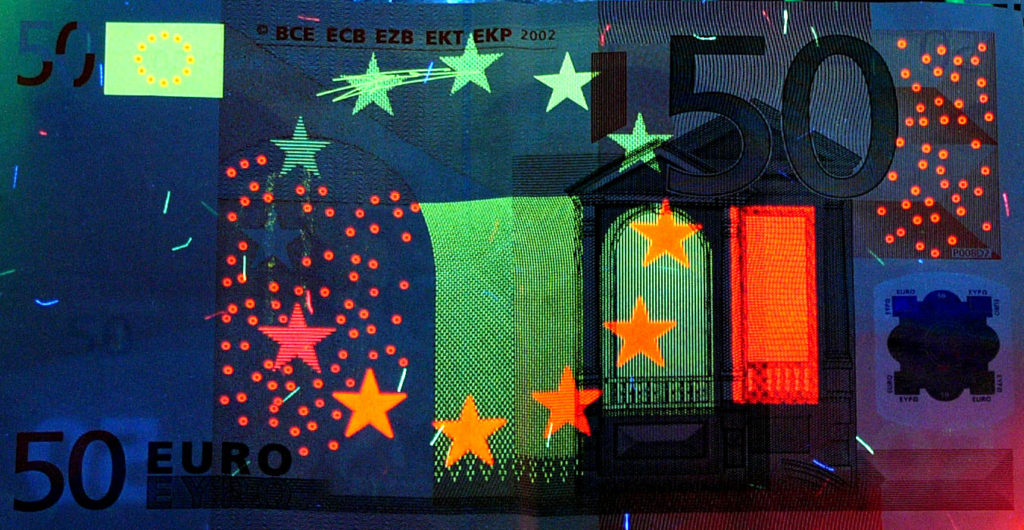Beautiful banknotes: Oberthur Fiduciaire takes full advantage of its history and technological change
Few of us ever heard about security printing industry, and even less about French security printer Oberthur Fiduciaire. But even so, the 170-years-old company prints over 5 billion banknotes a year, on behalf of major central banks the world over. Unbeknown to you, many of these banknotes probably already passed through your hands. Did you ever notice how beautiful and… high-tech they were?

Oberthur Fiduciaire banknote under UV lighting
The French company Oberthur Fiduciaire, yet one of the leading private security printers in the world specialized in the production of banknotes, is one of the forerunners in the sphere of banknote designing and printing. Indeed, the firm has a rich legacy and was founded in 1842 in the name of Imprimerie Oberthur by engraver, lithographer and amateur entomologist François-Charles Oberthur, in the West-France city of Rennes.
The company first built on the success of its print works such as the Post Office Almanac, telephone directories or posters when Oberthur Fiduciaire was the exclusive printer for the French western railway company. But above all, the company is renowned for the French Standard Reference for Tints it devised in 1905.
Later on, during a period when the Bank of France was experiencing supply difficulties, Oberthur Fiduciaire was called to rescue to print the first banknotes of its history. Despite this, the company experienced financial difficulties in the early 80’s, until it saw new light in 1984 after it was taken over and led by Jean-Pierre Savare, who has been the Chairman of the group since 1984.
Through years, the company had to be able to keep pace with the changing times and has evolved with developments in technology in banknote printing and security. “The technology has obviously changed, even though one of the main technologies used since the very beginning is still used today – intaglio printing, used almost exclusively in this industry for printing banknotes”, tells Thomas Savare, the current CEO of the company. “But there are many different techniques that have been adopted more recently, such as varnishing, which emerged maybe 10 -15 years ago¸ he explains. Today, printing a banknote is a multi-step process, you can have as much as 8 or 9 different processes and many different machines that come into play for producing banknotes, which has made the entire process all the more complicated”.
This change in technology is notably visible in the enhanced number of security measures that Oberthur Fiduciaire incorporates in its bank notes. “With the rise of computer technology, the democratization of high performance printing means and CAD tools, it is less a question of pure talent. The time of the ‘artists’ working in the background of a garage is over. Counterfeiters have become more professional and organized. So much so that behind each network of forgers, one inevitably finds engineers. This is why our company constantly strives to maintain a good length of technological advance compared to forgers,” says Thomas Savare.
This is reflected in the manner in which the French firm engages itself in research and development activities. “We spend about 5% of our turnover in R & D. We file regularly for new patents covering the technologies we implement, especially in two R & D fields: security like the anti-scanning technologies or patches optical effects and sustainability of the banknote,” states Savare. Then, several unique security tools have been developed and patented by Oberthur Fiduciaire, including Arc en ciel, DualTrack – a security thread for paper protection, Diaphan – a new generation see-through public recognition security feature and Swing – a printed security feature with variable optical effects on a transparent window.
The enhanced security aspect of bank notes and the growing smartness of counterfeiters mean that companies like Oberthur Fiduciaire need to be eminently spot on with banknote security. “We use a collection of different barriers to fight potential forgers. There are a lot of technologies used to make the paper itself, the threads, the fibers, the printing techniques… It’s a very thorough combination of different security features”, Savare explains.
However apart from security, Oberthur Fiduciaire also acquired a real competitive advantage derived from its French touch with respect to designing of bank notes, according to the company’s CEO. “It’s certainly a job that requires a highly developed sense of aesthetics … Thanks to the expertise we have developed over time with central banks around the world, we see how the symbolism conveyed by a banknote is important in the eyes of our customers,” Savare points out. Every banknote, he believes, must reflect a history, a culture, a set of common values and symbols of national pride as illustrious figures or monuments that make sense in the minds of citizens around the world. “In a way, it is also an instrument of social cohesion within a nation”, he considers.
The sense of aesthetics and understanding of the unique culture of a nation is among the core competencies at Oberthur Fiduciaire today, and the firm claims to have gained this from the deep-rooted rich legacy of the company. “Oberthur Joseph – the grand-son of the founder, François-Charles Oberthur – was also a wildlife artist of exception. We believe that aesthetics was anchored in the family genes. Today, we seek to cultivate this sense of aesthetics, and put at the service of cultures worldwide,” Savare concludes.
